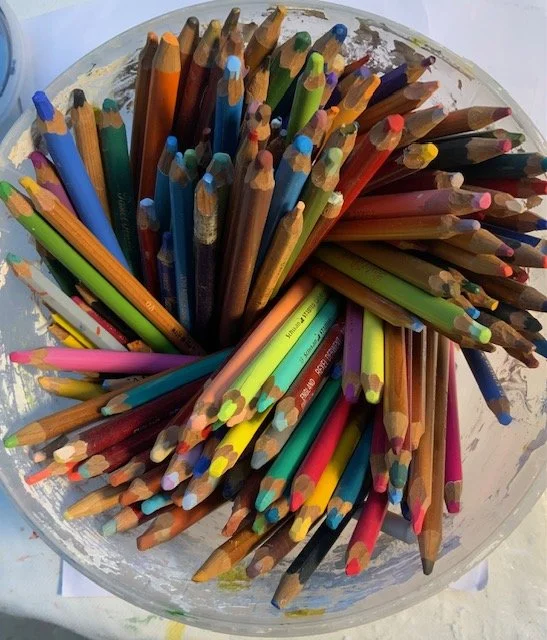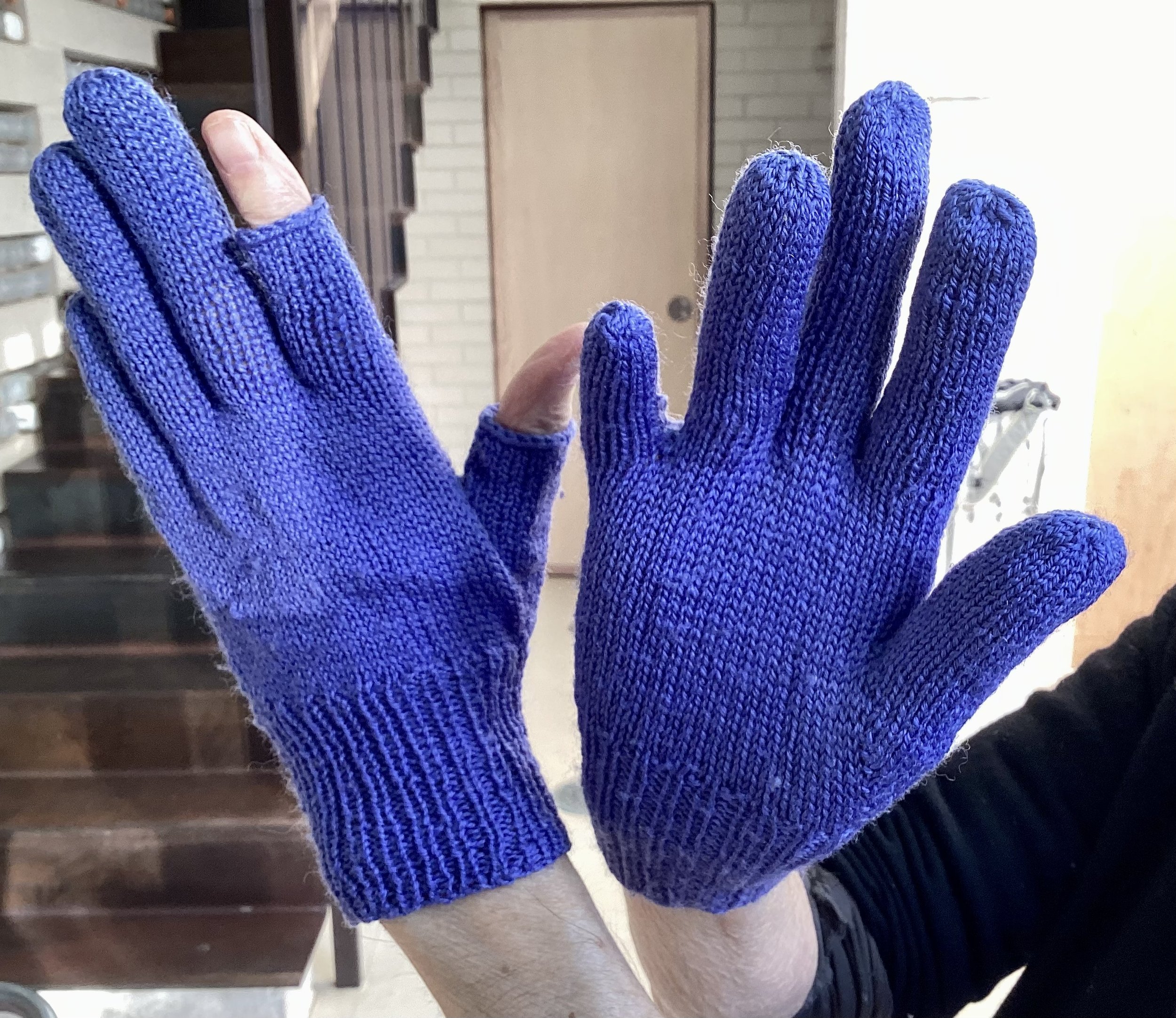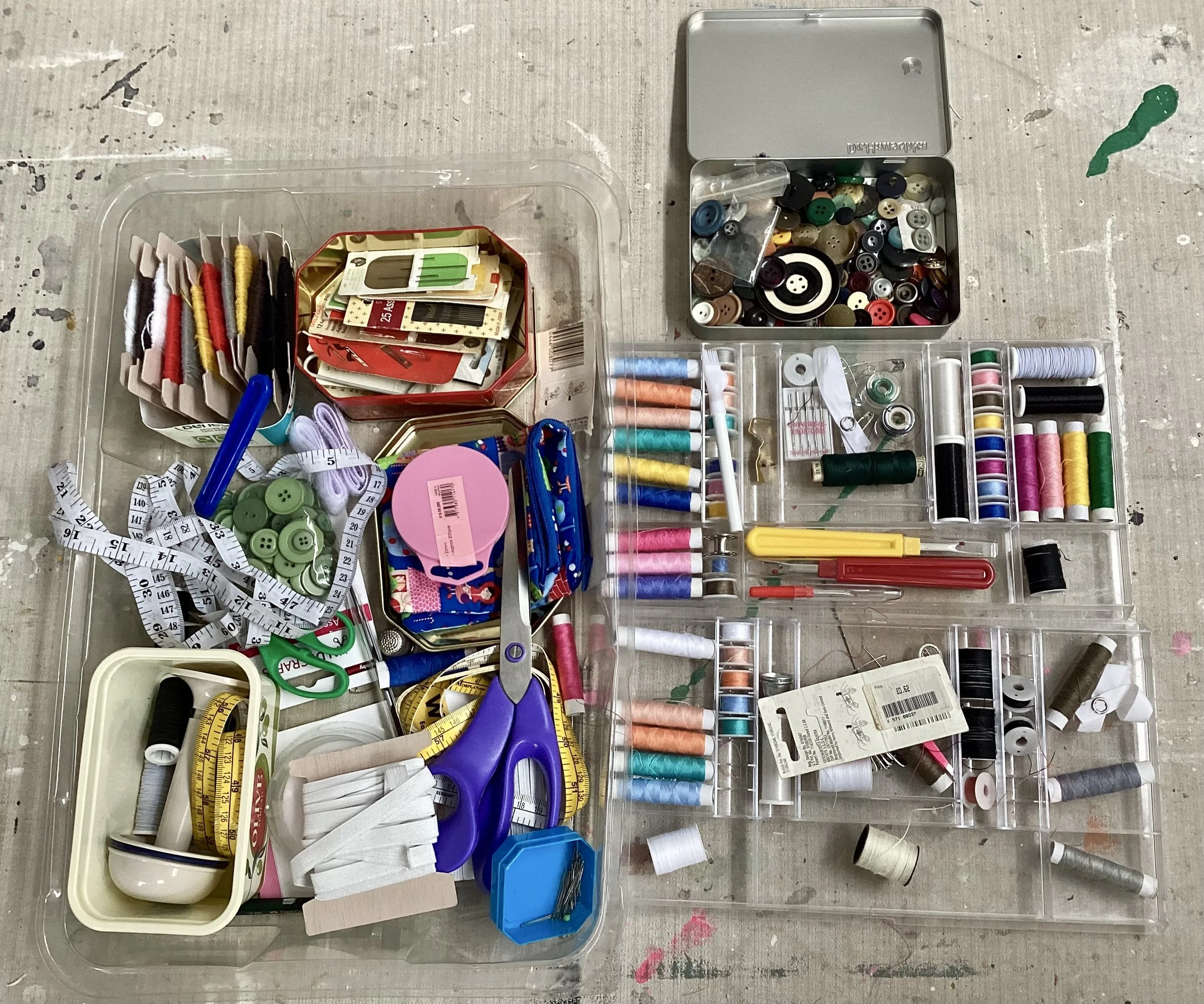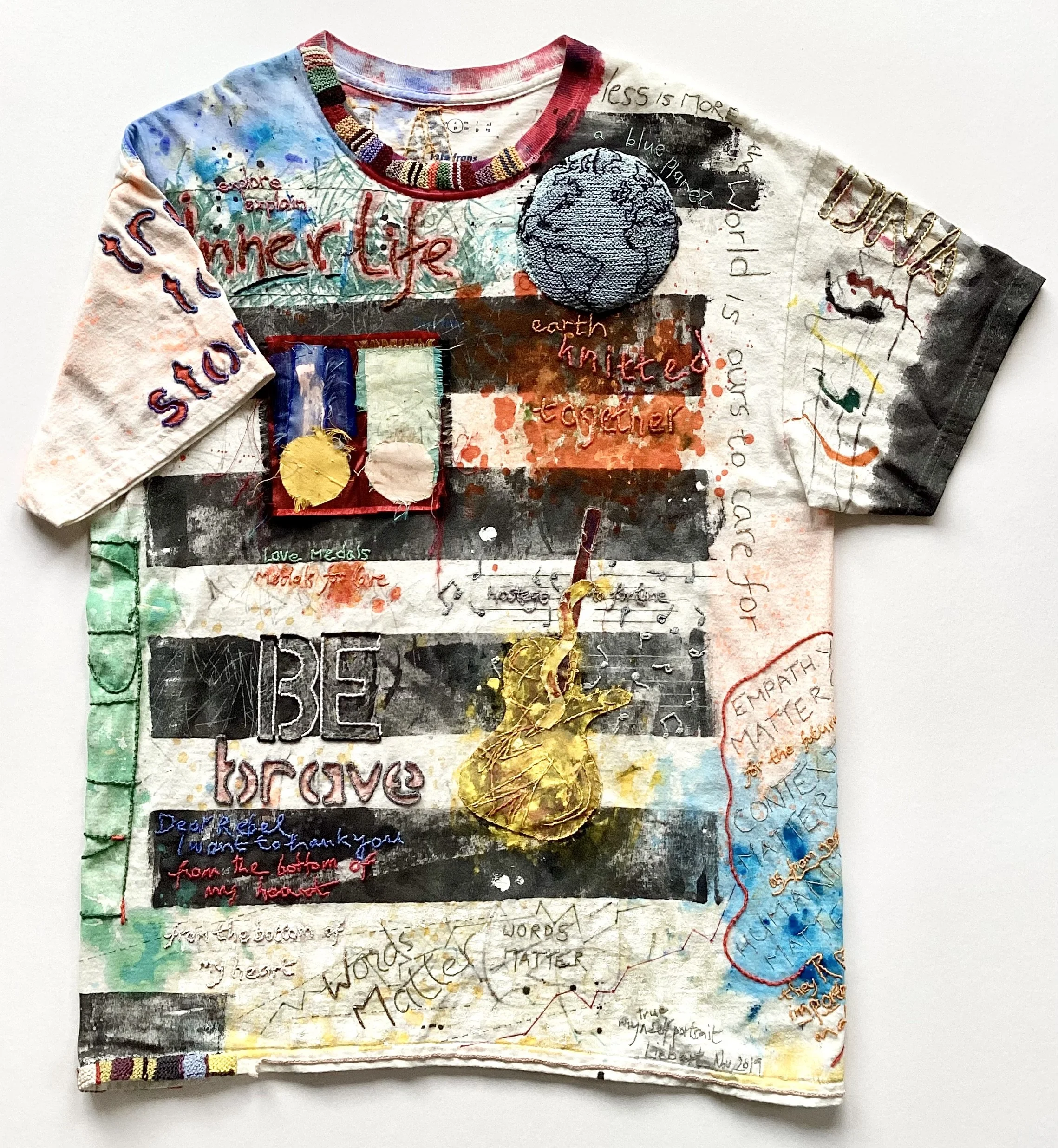Jude Marsh - Art, Making and Mending
Interview with Jude Marsh, written by Andy Barrett
Jude Marsh (who displays her work as Judy Liebert) is an artist living and working in The Meadows who runs the monthly Make Do and Mend sessions for the Green Meadows project. We met to talk about alterations, adaptations, and the importance of material mindfulness.
So, Jude, how did all this start?
The root of everything I do comes from my own personal philosophy that was absolutely ingrained in me as a child. I was born in 1946, only a year after the war ended and so for at least five, six, seven years of my life I remember having to be absolutely careful about everything, about every kind of material. Food and clothes and all sorts of stuff were incredibly precious and waste was sort of unknown. You had to make do and mend. I also think that there was a psychological thing of having won the war, and being a proud nation that there was this sense of striving; both to prove that we were winners after such a terrible time and also a mentality of not being defeated by even the smallest thing. And I still have it to this day.
Before I was born my parents lived in Birmingham and had been right in the middle of some of the worst bombing in the country and my dad, who was an engineer, built a shelter for the street which everyone used to get into whenever the sirens went off. So, this sense of building things, making things, was also part of my upbringing.
And where were you born?
In a place called Bramhall in Chesire, but I don’t remember much because when I was three or four we moved to Derbyshire, a place called Little Hayfield that speaks for itself. It was astonishingly beautiful and I was incredibly happy there. This love of nature has been with me ever since and is a really important part of my life. I just have to be in touch with it, either through my garden or walking. Just because you live in a city it doesn’t mean you can’t have nature all around you. And of course we’re very close to the river here.
If there was a patch of land in which any vegetables could be grown my father was out there with his spade; and we always had chickens. And my mother, who was very much a housewife like a lot of women of the time, was a really good amateur artist who always seemed to be in one art group or another. She was very dedicated and over the years as they moved around, she would always find a group to join, and if there wasn’t one then she’d go ahead and set one up. So again, this sense of doing things together to support and help and encourage each other was very important.
Do you think that’s why you became an artist yourself, because of your mother?
I’m not sure; obviously all these things feed into each other don’t they, but I was an actress for many years. I was very lucky in that within a year of coming out of drama school I found myself at the Royal Court working with some really good directors and playwrights. And at that time, in the seventies and into the eighties, theatre was very political. I potentially had a wonderful career on the horizon but like a lot of women as soon as I began a relationship that resulted in having a child, I had to give it all up. My partner then was the lighting designer for the theatre and was constantly working, leaving me at home with the baby. I always had an agent and got work but the really good parts evaded me after that. (Jude played the first gay character, Ruth Lyons, to appear in Eastenders).
It was such a different time. For instance, when I became a single parent I couldn’t join my friends’ babysitting club because I hadn’t got a partner. You really had to fight your own corner. So, after doing all sorts of jobs; working as a picture framer, driving a van for a florist, working for a fine wine merchants, decorating, gardening and all sorts of other things I retrained as an artist. And now I’m in this workshop seven days a week making things. It’s hugely satisfying.
‘I loved my crayons so much!’
‘My current tub of crayons’
And I suppose like my aversion to waste of any kind I find that my art is a compendium of everything I come across, any idea that interests me, or experience that has touched me, or a piece of material or rubbish that I find and think I can use in some way. It can be absolutely anything and it all ends up on a canvas one way or another.
Long Walk. 2004. 1820 x 1630 mm. Acrylic painted shoes
And this fundamental aversion to the idea of waste, in whatever form, has always been with you? Hence the Make Do and Mend sessions?
Yes, I have always been very careful with stuff and deeply respectful of stuff, including clothes. I struggle to throw anything away, and just about everything can be mended. To me this idea is central on so many levels and this fundamental principle of being careful about resources is increasingly important and at the heart of the environmental challenge that we are facing. This goes all the way from the material resources of the planet, and so always trying to maintain as low a carbon footprint as possible, right down to a piece of thread on the floor. It’s about a mindfulness over absolutely everything that comes our way, that demands we make a decision over how to use it and the environmental costs or the benefits of that. If you engage with environmental activism, if you criticise others for their actions, you have to think in this way. And, just like for my parents’ generation during the war and beyond when the idea of waste was appalling, there is real satisfaction and creativity in thinking and acting in this way
So what are the skills that are required to keep your clothes lasting longer? Because I have to admit that I think I’d struggle to sew on a button.
That’s because you’re a man and it’s to do with your age; we’re all partly stuck with the time of our youth. But at heart it requires an element of dexterity, of being good with your fingers because it is fiddly and that’s probably what’s been putting you off.
Given how quickly people use their fingers on their mobile phones these days we’re probably evolving into a species with increasingly nimble digits; so our mending abilities must be becoming enhanced.
It would be interesting to know; I'll have to ask at the next Make Do and Mend session! But yes, flexibility and fluidity in your fingers is key, and so much of the work is repeating very small movements. But you have to be able to identify the best way to solve the problem, to mend the material. That’s usually where people need instruction and help. If you’ve got a tear in a piece of clothing because it's old or because you’ve snagged it on a bramble you need to work out how you can pull the material either side of that tear together.
You might not care what it looks like so you could put a patch over it. But you might want to mend it so that the repair isn’t seen. And you want it to be strengthened; you want to feel confident that what you have done will hold. Sometimes you can actually do it with stitching, just going backwards and forwards, backwards and forwards with the right colour of cotton to make an area of strength that pulls the material together. Every problem requires a different solution, but you soon learn to understand the strategies and techniques you can use.
People have always been daunted about the idea of mending clothes I think, unless you’ve been brought up with it, but it’s really not difficult. And it means that you can keep wearing something you love for years on end; that you don’t need to throw something away because there’s a split or a tear. If you care for something you love by working on it then that clearly strengthens your relationship with it even further. And just about everybody at some point in their life needs clothes altering to fit them, either because they weren’t quite right when they bought them or because their body shape has changed.
How do the sessions work and who comes along?
There’s a real mix and often we get a lot of older men which interests me. I know that a certain generation, those who were in the forces, know how to sew but for many men of an older generation this has just not been part of their life. And they all really take to it; they’re very good, very thorough. You can see how satisfied they are with the work they’ve done, how pleased they are with it. Sometimes they’re a little embarrassed if I tell them they’ll need to take their trousers off if they need turning up but generally they’re very keen.
There are also quite a few younger people who come along and I would suggest that perhaps they are here for more ecological reasons, though I might be wrong about that. They’ve been brought up during a period where people expect to be able to buy very cheap disposable clothing which ultimately has an environmental and social cost that just isn’t reflected in its price, and so I think this idea of doing something that cuts against that is quite important to them. So, it’s a really good mix of the young and the old, of men and women, usually up to a dozen people and perhaps all with different reasons for being there.
This report about the true costs of cheap clothing is from the Economics Observatory a project that ‘bridges the gap between academic research, government policy and the general public. Our goal is to provide balanced and reliable answers to questions about the economy. The ECO team are drawn from across the countries and regions of the UK, with hubs in Bristol and the London School of Economics. By publishing daily articles, videos and charts, we believe ECO can help the public and policymakers better understand the numerous challenges facing countries around the world today’.
What equipment do you need?
We provide all the tools. Some people do have a few things that they bring themselves but generally we provide anything that they are likely to need, all the pins and needles and lots of material that's suitable for patching. Everything is sat on the table; all the cottons, all the threads, all the patches and hopefully we've covered most things that people require to solve their mending problem. There’s always lots of knitting needles and scissors, lots of threads of different colours, and the kind of interesting objects that you find in sewing kits like a stitch unpicker. We also have sewing machines but I don’t use those. I do all of the hand stitching and the wonkier jobs which a machine might struggle with.
Do you think there has been a lot of de-skilling around how we engage with clothing?
Absolutely. I was stitching by the time I was four or five years old! I was taught how to handle a needle because it was after the war and clothes were seen as an absolute luxury so you mended everything. My dad was forever gluing this to that and fixing this and that. We were all mending and fixing; that's what we did. But it really doesn’t take long to start to learn; there are people who arrived at the workshops feeling very uncertain who can now put their hand to all kinds of things.
Presumably clothes, like so many other things, through being cheaply mass made are inherently more disposable, more likely to rip and tear, less easy to mend?
Yes, and I always say to the group that if the fabric is worn through then ultimately it won't last, even if a mend will keep it going for a little bit longer. But that is enough for some people because you can get very attached to a piece of clothing, and that’s increasingly true now I think for men and boys. There has certainly been a sort of mentality for disposable clothes for some time, a period of what I would call serious slackness in terms of wasting materials. But it's changing; I really do get the sense that things are changing, if only a bit.
I get holes in my socks all the time and I just throw them away.
You should bring some along to one of our sessions then. I've taught lots of people how to darn socks and they love it. They go straight out to buy a darning mushroom, which is a lovely thing in itsel
There are a huge amount of YouTube videos and channels out there showing you how to mend clothing. Here’s one called DIY Clothing Repairs which gives you a good idea of the kind of work involved.
But what about the costs of the materials for all of this repair work?
Well again I just can’t let anything go to waste and so I have box full of old bits of wool and cotton and thread. It’s definitely the case that the haberdashers shop that you used to find in every town and village is no longer there, and you probably have to go to John Lewis who do have all sorts of materials. There used to be a wonderful shop in Nottingham, full of cotton and threads and things, but it shut down quite a long time ago.
Knit Nottingham is ‘a small independent yarn shop in the heart of Nottingham city Centre’. The Yarn Loft can be found on Hucknall Road. Other outlets may be available!
Should I buy a sewing machine?
I'd say that was purely to do with your mentality. If you're attracted to anything mechanical or like the possibility of doing things quickly and efficiently then yes. But if you're somebody like me who loves nothing more than a comfy chair, Radio Four and doing my mending then I can spend an extremely relaxing and pleasant hour or more mending and sewing by hand.
How many times can you mend something?
I always mend everything until it can't be mended, until it’s basically falling apart. I've got the same clothes now that I’ve had for around twenty years. Jeans can be mended over and over again. They wear out on the knees and around the bum and the buttonholes but that can all be darned. I’ll take the waistband off of a pair of jeans if it’s all frayed and replace it. I keep a stash of clothes that are beyond repair for that kind of job. Because I spend so much time here in the studio I don’t really wear many different kinds of outfits at all, so those other clothes I do have seem to last for ever.
Here’s a short film on how to mend jeans by darning.
And should we all learn to knit?
Absolutely! I love knitting and have knitted so many bits of clothing over the years. Knitting is another of those activities that can seem daunting to those who have never done it, but just think about what it is; two knitting needles and a ball of yarn. And from that you can create almost anything!
Again there are many films available that teach you how to get started with your knitting, such as this one.
I suppose one of the main issues with clothing is how many air miles it uses up. One cheap t-shirt may have travelled hundreds and hundreds of miles.
Yes, and I think this is what drives younger peoples’ interest in the idea of mending, or in this idea of ‘pre-loved’ clothing, rather than the idea of something being ‘second-hand’. But when I’m with a piece of fabric, I can't judge it on its past. It's just a piece of fabric and we want to do the best thing we possibly can with it from that moment.
The irony is that a really well-made piece of clothing, or a really good pair of shoes, may cost a great deal but will potentially cost you less in the long run because of its quality.
But you have to be in a situation to afford that in the first place, which is becoming more and more difficult for a lot of people. Which is why mending those items of clothing that you have really built a relationship with, that might have all sorts of stories caught up in it, is such a valuable thing to do. And we also have this idea that we must constantly keep washing our clothing, which is expensive in itself, uses up resources and wears things out. Again, it’s something to be mindful of. I've got things that might only come out once a year for some kind of special occasion that I don’t think I’ve ever washed.
Your artwork is very much canvas based, even if you use cloth or fabric as a material to work with. Have you ever created something that was purely made of material?
I made a bedspread, ‘Dreaming a House’. that was covered in stitched drawings and notes that I’d found when Julian was building this house. (Jude and Julian live in a self-built zero carbon house/studio). He’d write and draw these ideas and make these plans on scraps of paper that I would find and I thought they were so incredibly interesting, because they really tell the story of this house and how it was put together. And this house is a testament to all of these ideas of mindfulness, of detail, and of a desire to treat the environment with absolute respect and care. It was made as a bedspread but I entered it into the Royal Academy Summer Exhibition in 2011 when it won a prize for Best First Time Exhibitor. It was also installed in Byron’s bedroom in Newstead Abbey in 2015 as part of an exhibition, referencing the ‘thorough repair’ Byron carried out when he moved in, in 1808.
I don’t really think of myself as a painter as much as a ‘maker’ of work. I collage a lot of my pieces from all kinds of materials, many of which are recycled.
This piece is in the entrance hall of Loxley House, the offices of Nottingham City Council. It took ‘over 3 years to paint has 252 figures, every nationality on earth, and a dog and a cat, queueing to vote for the planet, set against a hot red burning earth. The painting is based on the images of the first free and fair elections in South Africa in 1994. I was deeply moved by the long colourful queues snaking their way to the polling stations. The painting is a call for all people of planet earth to come together for its wellbeing’.
You can see more of Jude’s work here.
What is the connection between your mindfulness about materials and your artwork?
It all comes down to that word ‘detail’. I feel that ultimately it's always about a mentality of detail. I see and I love detail. When I am looking at and feeling a piece of material I can sense the sort of life that it’s had, the stories that might be part of it, and the different things that you can do with it; the limitations and the possibilities. I think it’s that kind of care and attention, this fascination with the detail of the material, that does spill out into how I approach my artwork.
In many ways the kinds of objects that once allowed people to explore different kinds of materials, and to understand how things were put together and how they worked, things like clocks and radios, are vanishing with digital technology. Which means it becomes more difficult to engage with the materials and the science and the ideas behind an object, and to form a relationship with it that’s something beyond being a consumer.
Yes. And there’s a lovely feeling in the room during the Make Do and Mend sessions that is generated by that relationship with the materials and objects that are on the table. Maybe on some level it helps people feel a bit more in control of their world, which is a helpful thing. There’s an intimacy and a warmth that's really positive. It's like a quiet shout for want of a better expression.
Do you think this idea of mindfulness that you talk about, that is generated through this activity, spills out into the way people engage with the world more generally?
I know it’s optimistic and rather romantic but I do think so. I hope so. But I do think that generally people are becoming more mindful about things like this, and perhaps mending clothing is one route into a different way of engaging with the world.
And are there any emerging networks around making do and mending? Is there a world out there that you're connected to that we know nothing about?
I’m sure there is but I’m just involved with this group. If we have twelve people round a table getting stuck in and talking to each other then that’s enough for me.
When I leave are you carrying on with your art work?
Absolutely. It’s all about the process for me. I just love making it and I really don’t care what happens to it afterwards; it’s not something I really bother myself with which is why there is so much work accumulating here. If somebody is interested enough I’ll always show them what I’m doing and talk to people about it but I'm not seeking fame or fortune. I think by the time you’ve reached the age that I have, and I’m 80 next year, that you do become much more philosophical about things like that and the joy is all in the doing; like my Mum I suppose.
The Make Do and Mend workshops run every month at the Climate Hub building on Turney Street. There’s a break over summer and the Christmas and Easter holidays and the dates are always available on the Green Meadows Events page.




















